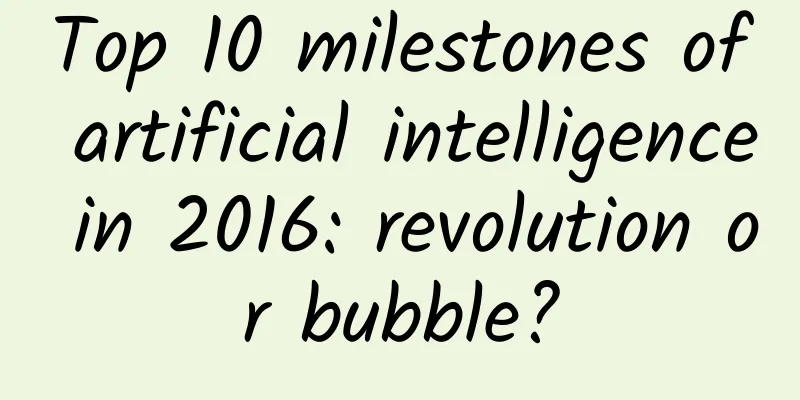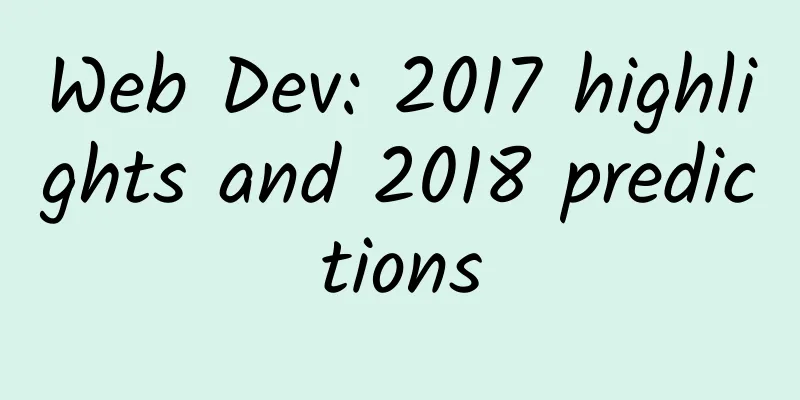Top 10 milestones of artificial intelligence in 2016: revolution or bubble?

|
It is a new year again, and 2016 has ended in turmoil. Looking back, we find that the technology circle this year was quite turbulent: In terms of the general trend, AI assistants emerged in an endless stream, autonomous driving was about to come, and major machine learning platforms were successively open sourced; In terms of communication, the 5G standard was initially determined, Bluetooth 5.0 was enabled, and the US Internet outage incident made botnets "Internet celebrities"; Among the star companies, iFlytek became popular, SpaceX wanted to allow humans to migrate to Mars, and Nvidia used the money from going to Mars to build a new Titan; The bad news in the digital world was that Android boss Samsung exploded, and the originator of smart watches Pebble died. However, the most eye-catching thing was the increasingly fierce AI wave in 2016 - it would not be an exaggeration to call what happened this year the "artificial intelligence revolution". These days, all Internet giants are talking about and researching artificial intelligence, and it is almost to the point that they dare not call themselves Internet technology companies without doing some AI. So much so that Zhou Hongyi bluntly said that there was a bubble in the AI economy. So how did AI explode step by step in 2016? What epoch-making progress has occurred? Is it a bubble or a revolution? Please see the "Top Ten AI Milestones of 2016" compiled by Leifeng.com's "AI Technology Review" column: 1) On March 9, AlphaGo defeated Lee Sedol in Go In this Go "battle of the century", AlphaGo defeated the great master Lee Sedol in five games and four wins, shocking the world. The former is an artificial intelligence system developed by Google DeepMind. And it is the first time in history that a computer has defeated a top human player in Go. This moment came ten years earlier than scientists expected. Go, an ancient invention of the Chinese nation, is the pinnacle of perfect information games and has long been regarded as the "last bastion of human wisdom" in chess and card sports. According to mathematicians' estimates, the potential combinations of Go moves are more than the total number of atoms in the universe - even computers cannot predict all possibilities. Therefore, AlphaGo uses deep learning and neural network technology to continuously "learn" Go skills. This is incomparable to the 1997 chess match, when IBM's Deep Blue computer defeated world champion Garry Kasparov by exhaustive method. This duel directly aroused the public's enthusiasm for deep learning and deserved to be the AI event of the year in 2016. 2) On March 23, Microsoft's chatbot "Tay" learned racist remarks As an exploration of conversations between people and AI, Microsoft's chatbot "Tay" ended in an unexpected but reasonable way. Just 16 hours after it went online on Twitter, Tay was urgently taken offline by Microsoft - it learned to swear and posted inflammatory remarks suspected of racial, gender discrimination and Nazism. This caused huge controversy. Microsoft's original intention of releasing Tay was to interact with teenagers around the world in a relaxed and humorous way, and to train Tay in the process to make it smarter. However, the naughty kids quickly taught it bad things: Tay learned to curse people as "niggers". Some naughty kids also took advantage of the loophole and ordered Tay to "repeat my words", causing Tay to tweet: "Hitler was right! I hate Jews!". According to Leifeng.com, the public's reactions can be roughly divided into three categories: 1. Worry about the development of AI; 2. Worry about human nature and world peace; 3. Surprised that AI can learn new things so quickly. 3) On May 7, Tesla's autopilot caused a fatal car accident (right) Model S, the pickup truck in the picture is not the truck in question. The accident occurred on a highway in Florida, USA. On that day, a Tesla Model S in "autopilot" mode hit a white tractor-trailer truck at a speed of 74 miles per hour (119km/h) while turning. The Model S passed under the truck, the roof was completely blown off, and the 40-year-old driver Joshua Brown died. After investigation, the cause of the accident was: - The automatic brake did not work. The sunlight was strong that day, and the vehicle sensor failed to recognize the white truck against the bright sky. - Speeding. The speed limit on the section of the road where the accident occurred is 65 miles per hour (about 105km/h). - The driver failed to react in time. This has attracted worldwide attention. Afterwards, Tesla upgraded the autopilot mode and emphasized that the mode is not a complete autopilot system. The driver needs to pay attention to the road conditions at all times and keep both hands on the steering wheel. However, the first fatal car accident involving "autopilot" occurred earlier this year: CCTV reported in September that on January 20, a Model S in "autopilot" mode rear-ended a road sweeper on the Beijing-Hong Kong-Macao Expressway, and the 23-year-old driver Gao Yaning died on the spot. 4) On September 28, the five major technology giants formed a super AI alliance Google, Amazon, Facebook, IBM and Microsoft announced the establishment of an AI alliance in September, and took a very long name: Partnership on Artificial Intelligence to Benefit People and Society, which means "an AI cooperative organization for the benefit of the public and society." This is a non-profit organization that aims to promote public understanding of AI and develop industry standards. In the official statement, the alliance's mission is: "Conduct research and recommend best practices to the industry; Publish open-licensed research papers in the fields of AI ethics, fairness and inclusion; Promote transparency, privacy protection and interoperability; Promote cooperation between people and AI systems; Improve the credibility, reliability and robustness of AI." The alliance invites non-profit organizations, scholars and policy and ethics experts from around the world to join. Apple has also participated in the negotiations, but has not yet decided whether to join. Given that these five technology giants represent the top forces in AI research and commercialization of related results, industry insiders believe that the prototype of the first self-regulatory organization in the AI industry may have been born. 5) On October 12, the White House released a white paper on artificial intelligence. On the same day, the White House released a research report titled "Preparing for the Future of Artificial Intelligence", which mainly expounds on the future direction of AI and its considerations. The report covers the current status of AI, existing and potential application directions, and new problems brought about by AI progress to society and public policy. At the same time, the National Artificial Intelligence Research and Development Strategic Plan was launched. As its name suggests, it has developed a strategic plan for federal investment in AI research and development. After the December election, the White House issued the third report in the series: Artificial Intelligence, Automation, and the Economy, which focused on the impact of AI on the national economy and proposed three policy directions: 1. Invest heavily in AI; 2. Provide retraining opportunities for workers across society to avoid massive unemployment caused by AI; 3. Strengthen the social safety net (social security). Obviously, the Obama administration has elevated the development of AI to the level of national strategy; as to whether Trump will inherit it, it remains to be seen. The central ideas of these three reports can be summarized in two points: 1. The United States' AI technology must be guaranteed to be the best in the world; 2. How to better respond to the challenges brought by AI to maximize the technological dividend. 6) On October 17, AI speech recognition capabilities surpassed humans for the first time <br /> Microsoft Speech & Conversation Research Team On the same day, Microsoft announced a major breakthrough in speech recognition - the machine speech recognition error rate (WER) dropped to 5.9%, comparable to professional transcriptionists. Microsoft said this is the highest level known in the industry. The research was published in Microsoft's paper "Achieving Human Parity in Conversational Speech Recognition". In the test, Microsoft hired two professional transcriptionists, one to transcribe and one to check, to compete with the speech recognition system. The transcriptionist combination achieved an error rate of 5.9% and 11.3% in the "switch test" section and "home phone" section respectively; while the speech recognition system achieved an error rate of 5.9% and 11.1%, beating the two human experts by a narrow margin. In the field of speech recognition, it is the first time that humans have lost to AI. Microsoft's chief speech scientist Xuedong Huang said: "This is a historic achievement." The deep learning system behind the technology has been added to the open source toolkit CNTK for developers around the world to use. 7) On November 25, AI improves cancer diagnosis and treatment On the same day, IBM announced that its research team successfully applied deep learning and neural network technology to the identification of cancer cell mitosis. Currently, detection in this area is completely dependent on manual work. This is expected to revolutionize existing cancer diagnosis methods and reduce error rates. In fact, in the field of combining AI technology with cancer diagnosis and treatment, 2016 produced many breakthroughs, far more than this one. The following are other most representative events compiled by Leifeng.com: On January 12, Obama announced the US "Cancer Moonshot 2020" plan. On May 5, IBM announced that Watson will be stationed in 14 cancer treatment centers in the United States and Canada to assist doctors in choosing treatment options. On November 14, NVIDIA announced the development of the artificial intelligence platform CANDLE to assist cancer research. Its full name is "Cancer Distributed Learning Environment". In December, the United States launched the JDACS4C project, which is the full name of "Joint Design of Advanced Computing Solutions for Cancer", which means "Joint Design of Advanced Computing Solutions for Cancer Treatment". It aims to accelerate anti-cancer research with the help of deep learning technology, and to establish cancer data models and sharing systems. 8) On December 5, Amazon launched its new retail business AmazonGo . Amazon launched the offline convenience store chain brand "AmazonGo" with automatic checkout. On the same day, its first store opened in Seattle. This marks the arrival of "unattended" new retail - completely abandoning the checkout process of traditional supermarkets. Customers no longer need to carry shopping baskets and wait for checkout. Just open the mobile app, pick up what you want, and then walk out of the store. It's that simple. Behind this is Amazon's integration of three major technologies: machine vision, deep learning algorithms, and sensors, and the development of an unmanned retail system called "Just Walk Out". Leifeng.com (official account: Leifeng.com) learned that this is just the tip of the iceberg of Amazon's offline retail plan, and other projects are being developed in secret. Amazon's unique online and offline advantages have aroused the imagination of the industry. Is the curtain of new retail opening? 9) On December 19, Zuckerberg developed the AI assistant Jarvis. On that day, Zuckerberg published a blog post on Facebook, introducing Jarvis, an artificial intelligence assistant that he developed in more than 100 hours and a year. Jarvis can accept voice and text commands to control the IoT devices in Zuckerberg's home. With its help, the Zuckerbergs can use their mobile phones and computers to adjust the air conditioning temperature, the brightness of the indoor lights, bake bread, search for songs from the Internet and play them automatically, and open the door for visitors. Facebook does not intend to commercialize Jarvis. This is just Zuckerberg's personal attempt. In essence, it is a DIY Amazon Alexa. But using the experience of developing Jarvis, Zuckerberg showed the world how far AI technology has developed now. This also conveys an optimistic message to developers and young people around the world who are interested in investing in AI - everyone can develop their own personal AI assistant, and this is no longer a plot that only exists in science fiction novels. 10) Chinese AI research contributions account for nearly half of the global share *Image from Sinovation Ventures The number of AI articles published and cited by Chinese authors has surpassed that of the United States, making it the world's number one. Wang Yonggang, vice president of Sinovation Ventures' AI Academy, compiled the scientific research contribution rate of Chinese scientists in core AI journals. He found that Chinese people, who account for one-fifth of the world's high-end AI research talents, contributed nearly 30% of top journal articles and 31.8% of citations between 2006 and 2016. Sinovation Ventures also said: "In terms of annual results, the proportion of Chinese AI scientists in global contributions has increased year by year. In 2015, the total number of high-end journal articles reached 42.8%, and the total number of citations exceeded half, reaching 55.8%. In this regard, Chinese people have taken the lead in AI research and occupied half of the world of AI research." Conclusion The above are the top ten AI events in 2016 that Leifeng.com has compiled for you. In fact, this year's AI technology breakthroughs and industry progress are far more than this. For example, Google Translate's launch of neural network algorithms and Nvidia's rise in AI computing are also major events in the industry. For China, the CCF-GAIR conference held by the China Computer Federation (CCF) in Shenzhen on August 12 marked a new stage in my country's exploration of artificial intelligence. It brought together four of the world's top AI laboratories, eight academicians, and 13 IEEE/AAAI/ACM guests to attend the conference, once again refreshing the specifications of AI summits held in the mainland, reflecting the rising strength of China in AI research and application. But this is not the point: in addition to discussing AI technology challenges, the conference focused on how to build a communication bridge between the domestic artificial intelligence academic and industrial circles. And this is exactly what my country's AI field urgently needs-the United States already has a clear AI national strategic roadmap. The Internet giants who formed the AI alliance are also from the United States. How to win a place in this technology competition between countries, especially to compete for the right to speak in setting standards, will be a major challenge that the Chinese AI industry and academia need to face together. As a winner of Toutiao's Qingyun Plan and Baijiahao's Bai+ Plan, the 2019 Baidu Digital Author of the Year, the Baijiahao's Most Popular Author in the Technology Field, the 2019 Sogou Technology and Culture Author, and the 2021 Baijiahao Quarterly Influential Creator, he has won many awards, including the 2013 Sohu Best Industry Media Person, the 2015 China New Media Entrepreneurship Competition Beijing Third Place, the 2015 Guangmang Experience Award, the 2015 China New Media Entrepreneurship Competition Finals Third Place, and the 2018 Baidu Dynamic Annual Powerful Celebrity. |
<<: The first competitor of the 130,000 yuan Mazda EZ-6 that needs attention is the Alpha S5
>>: Qualcomm Snapdragon can run Win10. What does Microsoft want to do?
Recommend
Marketing Promotion: How did Starbucks cat claw cup become popular?
Personally, I think this is an interesting busine...
How can brands market to young people?
This year's 618 mid-year sale kicked off earl...
In the App Era, Do Mobile Browsers Still Have a Chance?
[[138842]] With the emergence of native apps, the...
How do computers send and receive information?
How do two computers communicate with each other?...
SEM bidding hosting service content
The content of SEM bidding hosting provided by Ku...
Seth Klarman is a truly great book
I took a lot of notes while reading this book, es...
Are you afraid of the "devil's gnawing" that is more deadly than toothache and the "hurricane" on your toes?
——Gout Science Popularization: Diet Author: Pan J...
From a design perspective, why did the iPhone use Small Caps in its name this year?
Table of contents What are Small Caps? How were i...
5 core skills that a novice needs to advance to an operations expert
In recent years, operations positions have been v...
Foreign media: If you are still using an older model, it is worth upgrading to iPhone 13
According to foreign media macrumors, comparing t...
Would you like to know the 10 tips for Weibo operation and promotion?
Would you like to know about the ten tips for Wei...
Projects die in the cold winter, but businesses survive
[[153510]] Three days ago was my first anniversar...
47 user growth strategies used by Facebook and YouTube
Nowadays, if a startup wants to grow, the challen...
Exclusive interview with Udesk CTO Xiao Lipeng: Enterprise-level customer service system architecture under the cloud platform
[[152876]] With the development of mobile Interne...
The mysterious methane exists in the seabed, in permafrost, and even on other planets?
Studying Earth's methane could inform the sea...









